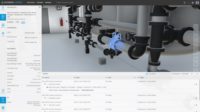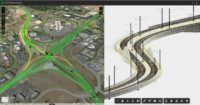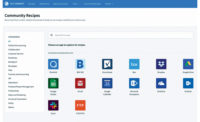San Rafael, Calif.-based Autodesk announced it's separating its cloud offerings into three separate platforms—one each for its major business divisions—while still promising data interoperability among all of its design and content creation tools at its first live and in-person Autodesk University trade show since 2019, held at the Ernest N. Morial Convention Center in New Orleans, Sept. 25 to 27.
The software giant is keeping its manufacturing tools such as Inventor on the Fusion cloud platform (formerly Fusion 360), but it's creating a cloud collaboration platform called Forma for all of its architecture, engineering and construction tools and services, including as Revit, AutoCAD and the Autodesk Construction Cloud. A third platform, called Flow, is being developed for the company's media, gaming and entertainment-focused products such as Maya and 3ds MAX. The company also announced its rebranding Autodesk Forge, a technology development platform, into Autodesk Platform Services and said it will develop a conceptual design tool based on the technology behind Spacemaker, a cloud-based, AI-driven, planning and development tool it acquired in 2020.
"The functionality that ends up in these various industry clouds is portable to the other clouds and all of these industry clouds are floating on a layer of granular data that can be transferred from one to the other," said Andrew Anagnost, Autodesk's president and CEO. "Fusion and Forma will speak to each other natively. If an AEC company needs some of the capability that implicitly lives in Fusion, it can be imported to Forma. So, that, that notion of convergence between industrial methods and construction methods is totally intact."
Anagnost says that Forma's services and tools will have workflows and delivery processes familiar to most contractors and designers, while also being able to use the manufacturing workflows and methods that some more advanced general contractors and specialty contractors now use. "Don't interpret it as these islands that are floating in different seas. No, they're all actually floating in the same lake. They all talk to each other and they will all share functionality."
Design Changes
The move to a set of distinct cloud platforms comes as Autodesk is facing pressure from more than 600,000 architects who believe development of the company's design tools, particularly Revit, has not kept up to take advantage of modern computing power. Two separate groups of European and Nordic architects have sent open letters to Anagnost saying their design process is hampered by having to use time-consuming work-arounds to accomplish what they need to do in Revit and other Autodesk design tools.
While maintaining that Autodesk does not necessarily agree with most of the demands in the letters, the company's position is that it takes customer feedback seriously, Anagnost said, "The one thing we do agree with is the graphics pipeline in Revit needs to be matured, and that's part of our standardizing on USD )universal scene description, a file format that allows users to interchange and augment arbitrary 3D scenes that may be composed of many elemental assets), so, that is absolutely going to get better," he said.
Anagnost and other Autodesk executives disagree that Revit needs to be replaced or is near the end of its development cycle. Anagnost said Autodesk's investment in Revit has not fallen off, but acknowledged the future of design is not the "point-and-click paradigm that you see in Revit. It's a different paradigm and that we think is important to bring to the market. And that's what Forma is and that's where we've been spending our energy for the last two years."
"The capability, as we're looking at this, is building out workflows." said Amy Bunszel, executive vice president of AEC design and Autodesk. "We're working with customers and we're figuring out what are the most high-value things we can do first with data. And we'll continue to kind of build from there."
Bunszel stressed that workflows may change to ones customers are adopting or gravitating toward as the Forma cloud offering evolves. For the forthcoming conceptual design tool based on Spacemaker's technology, she said it will bring early design decisions around sustainability such as building orientation and placement of energy systems seamlessly into Revit and other design tools that, eventually, will be handed over to facilities management.
Bunszel said many tools in the market now serve the conceptual needs of designers, but there really isn't one where early design data can seamlessly move to the next stage of design development. Because both the new conceptual design tool and Forma are being built around Spacemaker's technology, they can use its machine learning to generate many different design iterations based on early inputs about what clients or designers what from the performance of that building or piece of infrastructure.
More GIS Data Sharing
The Autodesk and Esri partnership that began in 2018 has risen to a new level of prominence at the conference, with multiple sessions on collaborating on BIM and geographic information systems (GIS) technology. The collaboration is also being encouraged in a new software bundle of Autodesk BIM Collaborate Pro and Esri’s ArcGIS GeoBIM.
"We're starting to really see the value of bringing the geospatial and location to the picture." said Micah Callough, technical director AEC and environmental consulting at Esri. "The other thing we're starting to see now that we've got the partnership established is we have the desktop cloud, cloud-to-cloud, we're beginning to branch out into a more direct workflow."
In a panel discussion about how engineering firms are using ArcGIS GeoBIM to deliver projects in the U.S., Canada and the Netherlands, Darin Welch, national geospatial and virtual engagement manager at HNTB, told audience members to think differently about project data.
"It's scalable and it's possible (to use GIS) on every project," Welch said. "If we're going to be able to adapt to the infrastructure challenges in the U.S. and and the world, we have to change our traditional approach to design and the integration of other solutions like GIS."






Post a comment to this article
Report Abusive Comment